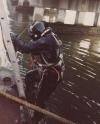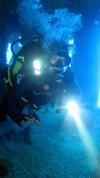
|
My opinion would be no. The NOAA buoys are typically too far away from a specific dive site, and they generally don’t reflect the true diving conditions because we are usually on a protected side of an island or on the mainland shore. The buoy date is really only good for water temp and if you happen to be doing an open ocean dive. I use at home more of the sites that the surfers use because it gets you a much closer representation. Save yourself the effort Greg.
|
|

|
SDBR - 5/03/2013 11:58 AM 
Good afternoon, Greg! I would say YES! The data buoys are not only out to sea, but are also along the coast, some just a few hundred feet offshore, some within a mile or two of shore, some a few miles further out, all of which can be seen by observing the NOAA map for the data buoys. Not only can their location be seen geographically, many have their location expressed by their name, as well as their lat/lon. Also, as seen on the buoy reports, the wind direction, speed, wave height, period, water temp., air temp., etc., is provided, all of which can be a factor in determining dive conditions. Reliable information is better than no information at all. Nothing wrong with providing that information resource/ tool to the members for their consideration in dive planning.
|
|

|
I would go there from DB if you did Greg. The reason is clear, the long and short range surf reports are based on program calculations, they’re great for use in general, and sometimes very wrong. It goes with the whole forecasting dilemma of predicting what’s gonna be from storms thousands of miles away, they get updated of course.
To get what’s happening right now in terms of temps, swells, periods, winds at any buoy and one can find accurate data. In California it’s imperative to know accurate info at times. Some dive sites are far away 10, 20, 30 miles. Some private boaters don’t leave without knowing buoy data. I guarantee that Commercial Dive Boat Captains use them also. Even shore diving I can know where it is and when opposed to a website that only updates every few days.
|
|

|
I sometimes use the NOAA wave and wind info before heading off to a beach dive or NC but for the most part those buoys are so far offshore that they are useless for diving conditions. For the beach dives I’ve found webcams at surf clubs and inlets to be more usefull :)
|
|

|
Maybe a link or being able to toggle them on/off on Scuba Earth.
Surf Web Cams are a great idea - Seeing is believing. I think we can already put Web Cam links onto Dive Site location sheets so that’s just something we need to add as we create/update the sites.
|
|

|
Yes if users have the ability to toggle.
|
|

|
I have always found it to be useful so I would add it.
|
|

|
When adding new options to the site the most important to consider is ease of use and limiting web site clutter.
If you can make it easy to find and easy to use it seems like a nice one-stop options for people who would make use of it.
It may even drive new users to the site through web searches.
If you have the time I would say add it in.
|
|

|
Here in Hawaii I often use the buoy data to plan dives, both from boat and from shore. If there is a way to toggle the info off for people who do not use it, I would say it would be a winner.
|
|